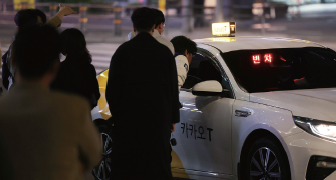Passengers looking for a ride over short distances are facing difficulties booking cabs due to the destination display function of taxi applications. On April 11th, the Passenger Transport Service Act (PTSA)’s amendment was proposed, including a new bill to eliminate the display of destinations on taxi-hailing applications. As the revision has sparked heated debates, the Sungkyun Times (SKT) delves into the ongoing controversy and contemplates potential suggestions.
Taxi Destination Non-Disclosure Bill?
-Changes Brought by Taxi-Hailing Apps
In the background of the PTSA’s revision, the emergence of taxi platforms plays a huge role. Today, people commonly use online call services rather than flagging one. According to 2020 research by the Seoul Institute, 42% of taxi passengers get their rides through applications. However, the rapid growth of taxi-hailing platforms has caused a reversal of its call mechanism — taxis picking and choosing their passengers. Clients could grab taxis only if the driver accepted them after examining their destinations. This is because those traveling shorter distances could discourage drivers to accept them, as the fares are less profitable. Park Jeong-yoon (Freshman, Social Sciences) said, “I tried to book a cab late at night to reach my house nearby but failed to do so after waiting a long time.” In fact, the Seoul Metropolitan Government (SMG)’s 2022 analysis of Kakao Taxi proves that numerous taxi drivers reject calls for short distances; the success rate for short routes during weekday night hours was only about 23%. To address this issue, an amendment of the PTSA regarding the masking of destinations was presented to the National Assembly on April 11th and is in the process of enaction.

-Scrutinize the Reformed Mobility Bills
Seoul City’s effort lies behind the proposal for the taxi amendment. According to Article 16 of the PTSA, rejecting taxi customers without a legitimate cause is patently illegal; thus, refusing rides for short-distance customers is prohibited. As a transportation hub, Seoul City has tried to eliminate the discrimination among consumer demands and provide fair distribution services for public convenience. The city government has continually required taxi platform owners and the Ministry of Land, Infrastructure, and Transport (MOLIT) to mask destinations on booking apps. With such attempts, the provision mandating taxis to hide destinations has come up in the revised Article 49 of the PTSA. If adopted, the bill would prohibit platform intermediaries from taxi drivers from disclosing passengers’ destinations before getting in the vehicle, and a fine of up to \10 million will be imposed when violated. Currently, MOLIT, SMG, and a few taxi organizations have agreed to the renewal. In addition, lawmakers have expressed that the act could be applied not only to taxis under online platforms but also to regular taxis that can be hailed for free, consequently guaranteeing public interest.
Controversy of the Revision
-Pros Setting the Seal on Expected Benefits
Regarding the revised act, proponents focus on the unfulfilled late-night taxi demand that has been increasing recently. According to 2022 data from Kakao Mobility, the volume of calls in Seoul between 10 p.m. and 2 a.m. jumped over 28% after the lift of social distancing measures. Despite such a situation, taxi supplies are in great shortage. Research from the Federation of Korean Taxi Worker’s Unions (NFTWU) shows that the number of taxi drivers has dropped from around 100,000 in 2019 to 70,000 in 2022. However, the SMG points out the destination display function as the main cause of the supply limitation during late-night hours. Amid these issues, on April 20th, NFTWU announced that the revised bill would effectively deal with the problem by gradually marking an end to the taxi industry crisis. Until now, taxi platforms were given the freedom to display destinations, burdening consumers with heavier fares to have their rides accepted. Seoul seeks to restructure its ride-hailing system with legal measures to ensure affordable fares for citizens and solve the taxi supply shortage. While customers are losing trust due to repeated short-ride denials, proponents expect the bill will work positively for platforms in regaining trust and developing a more favorable brand image.

-Concerns of Backfire Effect
Meanwhile, the mobility platform industry and the Ministry of Small and Midsize Enterprises (SMEs) and Startups express concerns about the bill’s adverse impacts. They argue pursuing a cause-elimination approach would result in a decline in call acceptance rates and an eventual demand-supply contradiction. Tmoney, a transportation system operator regulated by SMG, launched Gbro, a taxi-hailing application, in April 2018. The software masked destinations and charged fines when drivers refused to carry passengers without adequate justification. However, with the taxi industry’s poor cooperation, the app became a failure. A taxi driver from Kakao Taxi said to the SKT, “There were only a few coworkers who used Gbro because of its strict regulations.” At this point, opponents assert rushing into destination-free laws will have chaotic consequences, as the prior instance indicates. Additionally, they argue that once the bill passes, the work environment of taxi drivers will deteriorate, ultimately leading to the ineffectiveness of taxi services. Drivers might not be able to rest between shifts or have a meal due to distant destinations, resulting in a poor working environment.
Future of Legislation Amid Taxi Chaos
-A Constant Flexible Rate Charging System
To solve its chronic problems, the taxi industry must implement a permanent elastic fare structure. The inconsistency between the demand and supply could be moderated by adopting a flexible pricing system — a strategy that adjusts pricing based on the route’s time, location, distance, and traffic conditions. It will be a solution to provide more income for taxi drivers and enhance passengers’ convenience at the same time. In areas where the demand exceeds supply, the system would automatically raise the fares. In this way, the taxi supply would naturally increase as taxi drivers would relocate to regions of high demand for greater profits. However, if the system is implemented only during late-night hours when taxi rides are particularly scarce, there could be a risk for the supply to cut off at the borderline. Therefore, flexible pricing should be conducted all the time. The permanent application would allow taxi customers to pay less in locations when supply exceeds demand, eventually helping taxi firms to attract clients. For instance, Uber, the ride-sharing firm, has been adopting a constant flexible charge system to the taxi sector abroad. Its precise pricing method guarantees the convenience of app users and drivers. Likewise, a flexible pricing structure with an equilibrium would promote the efficiency of both the consumers and drivers while avoiding unconditional fare rises.
-Running a Regulatory Sandbox
Launching Demonstration Special Cases (DSC) within the regulatory sandbox could also introduce beneficial transformations in the taxi industry. DSC is a crucial mechanism of a regulatory sandbox, which loosens preexisting regulations to enable the entry of a new industry. For now, one must acquire a license and complete the necessary training before driving a taxi. However, DSC permits the issuance of temporary taxi driving licenses, providing speedier employment to job seekers. KM Solution, a subsidiary of Kakao Mobility, is one of the firms that issued such licenses. DSC allows individuals to get provisional licenses before obtaining actual taxi driver licenses. It leads to a stable supply of taxis and an inflow of new taxi drivers. DSC also helps improve the driver’s working conditions; KST Mobility has utilized DSC to carry out an independent parking system, while the current law only allows drivers to exchange shifts in designated garages. By allowing drivers to conduct shifts from locations other than the depot, they can plan their driving routes based on their present spot. Furthermore, implementing regulatory sandboxes holds great potential to resolve the challenges of an aging driver population and high turnover rates. Lastly, it can ensure stable taxi services regardless of the distance covered by providing a conducive environment to test new approaches and technologies.

Since the proposal of the PTSA’s revision, the ongoing discussion surrounding it has not been silent. Amidst such contentious controversy, ensuring a harmonious balance between taxi supply and demand would achieve a more stable taxi industry. To reach this goal, permanent flexible rate charging and the regulatory sandbox can play an important role. The SKT hopes such methods could encourage innovative reforms within the taxi industry, ultimately contributing to its overall stability.
